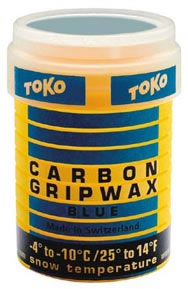Form
As I said on the intro page, I will focus on classic skiing (which is skied in a track).
To maximize speed, Nordic skiing is more about form than probably any other sport. Brute strength and athletic prowess certainly have their advantages, but these pale in comparision to proper technique.

[www.tokowax.com]
While the shape of classic skis is slightly different than that of skate skis, the real difference is that classic skis have a "kick zone." This is a spot directly underneath the foot that has kick wax applied to it. Kick wax is a sticky poly-hydrocarbon that in theory is only supposed to provide a sticky surface from which to push back from. If the skier cannot push backwards, by Newton's Third Law, he cannot go forwards. Thus the more push back against the foot, the more thrust forward.
Another form of wax is glide wax, usually made of fluorocarbons. On classic skis this is applied to everywhere on the ski except the kick zone. This is because glide wax is exactly the opposite of kick wax; glide wax reduces the frictional coefficient between the skis and the snow whereas the kick wax increases it. Different kick and glide waxes are used at different temperatures and different snow conditions.
Certainly one of the most important and difficult tasks of race skiing is to find the balance between the kick and glide. If there is too much kick, the skier ends up running the entire race; not enough kick and striding is out of the question.
Classic Forms
There are three forms of Classic:
Classic Stride

[Justin Priest]
Classic Stride is the most traditional form. It is skied in a track and is left kick, glide, right kick, glide. When the left arm plants the pole, the right leg is at the furthest back that it will go. As the arm comes back, the opposite leg comes forward. Conversely, the arm and leg on the same side come forward and backward as one, as if there was a string tied to them. When the arm is thrown back, as in the picture above, the opposite foot "plants" the ski, allowing the wax to set, thus increasing the frictional coefficient, and giving a much better kick. Notice in the picture above that the left arm and left leg are both back and that the right arm and leg are both forward. This is because of Newton's Third Law; the action of throwing the arm and leg forward, causes an action in the opposite direction, slowing the skier down. Good technique dictates letting both the arm and leg go backwards with the reaction thus setting up for the next kick.
Double Pole

[Justin Priest]
Double Poling is used at higher speeds (gentle downhills or flat terrain) because the mass of the skier is distributed over both skis, thus reducing the kinetic friction. Compare this to the stride where one ski has almost all the mass. Another advantage of double poling is that it uses abdominal and lower back muscles, which are very strong and don't often get used in race (other than with this motion) so the muscles are fresh!
One important point of double poling is to only bend at the midsection. The effect of this is that the Potential Energy is higher when standing up and lower when bent over forward. This is because the center of mass is much higher when standing up than bent over. The Potential Energy is transformed into linear kinetic energy by placing the weight on the poles. Potential Energy (U) is equal to the mass times gravity time height (U = mgh). Another way to improve form is to raise up on your toes (as she is about to do in the picture above). This raises the height almost 0.1m which translates into almost a 10% increase in Potential Energy.
Another tip that is directly from Physics is to thrust the lower legs forward as soon as the push from the pole is ending. The effect of this is that the action of moving the mass of your legs forward causes a reaction backward, giving more push through the poles. This is Newton's Third Law in action: the action moving forward, causes a reaction backwards, which gives more power forward.
Double Pole Kick

[Justin Priest]
To be fair, this isn't necessarily a different form, yet simply a mix of both types. It is the double pole motion with an added kick by one leg, usually alternating legs so that one doesn't tire out too quick. The kick is done at the time when the arms are being lifted from just after the extension of the double pole.
There is better grip when doing a double pole kick because the action of bringing the arms forward during the kick, causes there to be more down force on the ski, thus increasing Ff (the Frictional Force).
If you can, download this video (3.9 Mb) of Mika Myllyla (Finland) skiing in a race. To properly understand technique it must be viewed in motion. He starts out with classic stride, then moves into a double pole, tucks, then back into stride. Beautiful.....